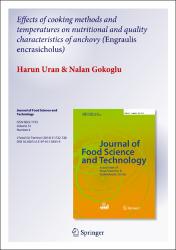Effects of Cooking Methods and Temperatures on Nutritional and Quality Characteristics of Anchovy (Engraulis Encrasicholus)

Göster/
Erişim
info:eu-repo/semantics/embargoedAccesshttp://creativecommons.org/licenses/by-nc-nd/3.0/us/Tarih
2014-04Üst veri
Tüm öğe kaydını gösterKünye
Uran, H., Gökoğlu, N. (2014) Effects of cooking methods and temperatures on nutritional and quality characteristics of anchovy (Engraulis encrasicholus). Journal of Food Science and Technology. 51(4):722–728.Özet
The aim of this study was to determine the nutritional and quality characteristics of anchovy after cooking. The fish were cooked by different methods (frying, baking and grilling) at two different temperatures (160 °C, 180 °C). Crude ash, crude protein and crude fat contents of cooked fish increased due to rise in dry matter contents. While cooking methods affected mineral content of anchovy, cooking temperature did not affect. The highest values of monounsaturated fatty acids were found in baked samples. Polyunsaturated fatty acids in baked samples were also high and similar in fried samples. Fried samples, which were the most preferred, lost its nutritional characteristics more than baked and grilled samples. Grilled and baked fish samples can be recommended for healthy consumption. However, grilled fish samples had hard texture due to more moisture loss than other methods. Therefore, it is concluded that baking is the best cooking method for anchovy.
Kaynak
Journal of Food Science and TechnologyKoleksiyonlar
- Makale Koleksiyonu [282]
Aşağıdaki lisans dosyası bu öğe ile ilişkilidir:



















